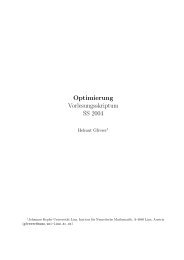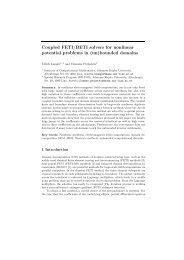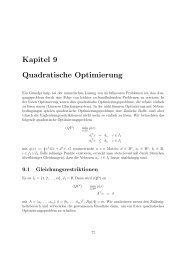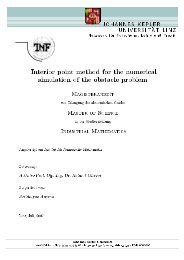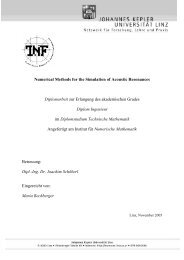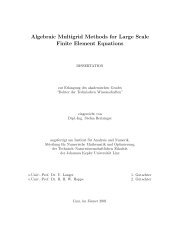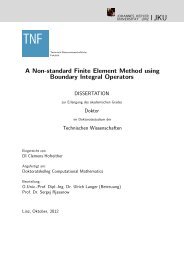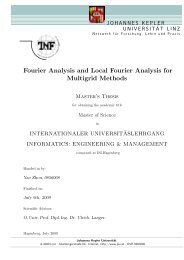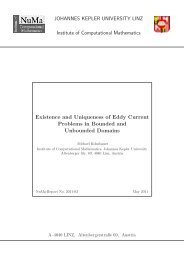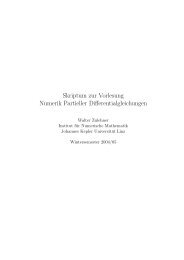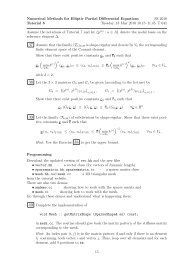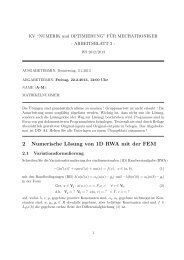PDF file - Johannes Kepler University, Linz - JKU
PDF file - Johannes Kepler University, Linz - JKU
PDF file - Johannes Kepler University, Linz - JKU
Create successful ePaper yourself
Turn your PDF publications into a flip-book with our unique Google optimized e-Paper software.
CHAPTER 2. PRELIMINARIES 22<br />
Figure 2.3 A quadrilateral is discretized by decomposition into its sub-triangles.<br />
PSfrag replacements<br />
S 3<br />
S 4<br />
S 5<br />
S 1<br />
S 2<br />
As the midpoint has only connections to S 1 ,. . . ,S 4 — also in the fully assembled matrix<br />
— there would be a line like<br />
a 51 x 1 + a 52 x 2 + a 53 x 3 + a 54 x 4 + a 55 x 5 = f 5<br />
in the system (where x is the solution vector, f the right hand side). Thus we can locally<br />
eliminate the entries for S 5 and get the resulting element matrix<br />
⎛<br />
⎞<br />
a 11 − a 15 a 51 /a 55 a 12 − a 15 a 52 /a 55 −a 15 a 53 /a 55 a 14 − a 15 a 54 /a 55<br />
⎜a 21 − a 25 a 51 /a 55 a 22 − a 25 a 52 /a 55 a 23 − a 25 a 53 /a 55 −a 25 a 54 /a 55<br />
⎟<br />
⎝ −a 35 a 51 /a 55 a 32 − a 35 a 52 /a 55 a 33 − a 35 a 53 /a 55 a 34 − a 35 a 54 /a 55<br />
⎠<br />
a 41 − a 45 a 51 /a 55 −a 45 a 52 /a 55 a 43 − a 45 a 53 /a 55 a 44 − a 45 a 54 /a 55<br />
(and additional right hand side terms if f ≠ 0).<br />
This idea can be generalized to any cell-type (e.g. pentagons, pyramids, hexahedra,<br />
octahedra, or prisms). First, one has to split the cell into triangles resp. tetrahedra and<br />
then eliminate the auxiliary unknowns locally.<br />
2.3 The Non-Stationary Problem<br />
In the non-stationary case we use the method of lines for time integration. First, the weak<br />
formulation and the FEM approximation in the space variables (with time dependent<br />
coefficients) is performed as shown above to get the system<br />
d<br />
dt (u h, v h ) 0 + a D (u h , v h ) + a C (u h ; u h , v h ) + b(v h , p h ) = 〈F, v h 〉 ,<br />
b(u h , q h ) = 0<br />
(plus initial conditions), a system of ordinary differential equations, where standard methods<br />
of time integration can be applied [HWN00].<br />
To show two examples thereof, we assume that the k-th time step has length δ k and<br />
that the right hand side is constant in time, and we search the discrete solution (u k , p k ) at<br />
time t k = t 0 + ∑ k<br />
i=1 δ i.



